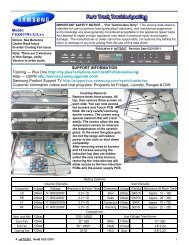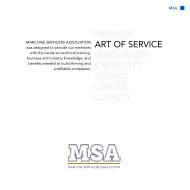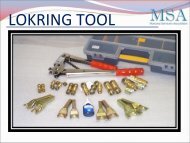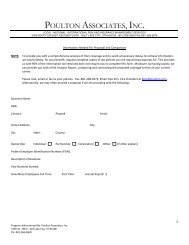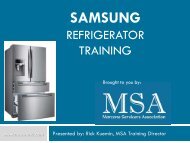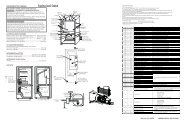C:\Documents and Settings\Allen - MSAWorld.com
C:\Documents and Settings\Allen - MSAWorld.com
C:\Documents and Settings\Allen - MSAWorld.com
Create successful ePaper yourself
Turn your PDF publications into a flip-book with our unique Google optimized e-Paper software.
The following are specific<br />
requirements for proper <strong>and</strong> safe operation of<br />
your dryer. Failure to follow these instructions<br />
can create excessive drying times <strong>and</strong> fire<br />
hazards.<br />
Do not use plastic flexible duct to exhaust the dryer.<br />
Excessive lint can build up inside exhaust system <strong>and</strong><br />
create a fire hazard <strong>and</strong> restrict air flow. Restricted air<br />
flow will increase dryer times. If your present system is<br />
made up of plastic duct or metal foil duct, replace it<br />
with a rigid or flexible metal duct. Ensure the present<br />
duct is free of any lint prior to installing dryer duct.<br />
If the dryer is not exhausted outdoors, some fine lint<br />
will be expelled into the laundry area. An accumulation<br />
of lint in any area of the home can create a health <strong>and</strong><br />
fire hazard. The dryer exhaust system MUST be<br />
exhausted to the outside of the dwelling!<br />
Do not allow <strong>com</strong>bustible materials (for example:<br />
clothing, draperies/curtains, paper) to <strong>com</strong>e in contact<br />
with exhaust system.The dryer MUST NOTbe exhausted<br />
into a chimney, a wall, a ceiling, or any concealed space<br />
of a building which can accumulate lint, resulting in a fire<br />
hazard.<br />
Exceeding the length of duct pipe or number of elbows<br />
allowed in the "MAXIMUM LENGTH" charts can cause<br />
an accumulation of lint in the exhaust system. Plugging<br />
the system could create a fire hazard, as well as increase<br />
drying times.<br />
Do not screen the exhaust ends of the vent system,<br />
nor use any screws or rivets to assemble the exhaust<br />
system. Lint can be<strong>com</strong>e caught in the screen, on the<br />
screws or rivets, clogging the duct work <strong>and</strong> creating a<br />
fire hazard as well as increasing drying times. Use an<br />
approved vent hood to terminate the duct outdoors, <strong>and</strong><br />
seal all joints with duct tape. All male duct pipe fittings<br />
MUST be installed downstream with the flow of air.<br />
Explosion hazard. Do not install the<br />
dryer where gasoline or other flammables are kept or<br />
stored. If the dryer is installed in a garage, it must be a<br />
minimum of 18 inches (45.7 cm) above the floor. Failure<br />
to do so can result in death, explosion, fire or burns.<br />
MAXIMUM LENGTH<br />
of 4” (10.2 cm) Dia. Rigid Metal Duct<br />
correct<br />
VENT HOOD TYPE<br />
(Preferred)<br />
Number<br />
Louvered<br />
of<br />
90°<br />
Turns 4”<br />
(10.2 cm)<br />
(6.35 cm)<br />
0 60 ft. (18.28 m) 48 ft.(14.63 m)<br />
1 52 ft. (15.84 m) 40 ft.(12.19 m)<br />
2 44 ft. (13.41 m) 32 ft. (9.75 m)<br />
3 32 ft. (9.75 m) 24 ft. (7.31 m)<br />
4 28 ft. (8.53 m) 16 ft. (4.87 m)<br />
Number<br />
of<br />
90°<br />
Turns<br />
MAXIMUM LENGTH<br />
of 4” (10.2 cm) Dia. Flexible Metal Duct<br />
VENT HOOD TYPE<br />
(Preferred)<br />
4”<br />
(10.2 cm)<br />
Louvered<br />
0 30 ft. (9.14 m) 18 ft. (5.49 m)<br />
1 22 ft. (6.71 m) 14 ft. (4.27 m)<br />
2 14 ft. (4.27 m) 10 ft. (3.05 m)<br />
3 NOT RECOMMENDED<br />
incorrect<br />
(6.35 CM)<br />
INSTALLMALE FITTINGS IN CORRECTDIRECTION<br />
In installations where the exhaust system is not<br />
described in the charts, the following method must be<br />
used to determine if the exhaust system is acceptable:<br />
1. Connect an inclined or digital manometer between<br />
the dryer <strong>and</strong> the point the exhaust connects to the<br />
dryer.<br />
2. Set the dryer temperature to low heat <strong>and</strong> start the<br />
dryer.<br />
3. Read the measurement on the manometer.<br />
13<br />
4. The system back pressure MUST NOT be higher<br />
than 0.75 or lower than .10 inches of water column.<br />
If the system back pressure is less than 0.75 inches<br />
<strong>and</strong> more than .10 inches of water column, the<br />
system is acceptable. If the manometer reading is



